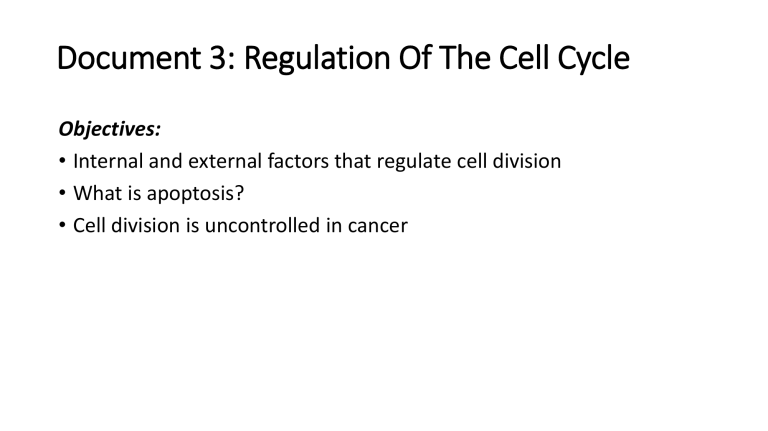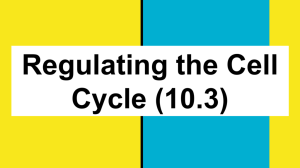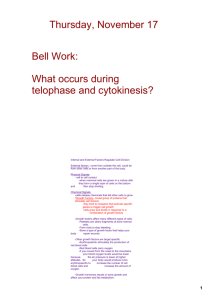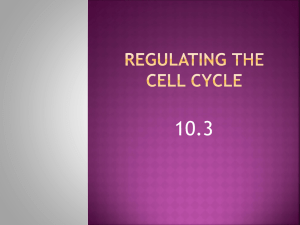
Document 3: Regulation Of The Cell Cycle Objectives: • Internal and external factors that regulate cell division • What is apoptosis? • Cell division is uncontrolled in cancer Internal and external factors that regulate cell division • Both internal & external factors regulate cell cycle in eukaryotic cells • External factors come from outside the cell like: 1. Messages from nearby cells 2. Messages from distant parts of the organism’s body • Internal factors come from inside the cell like: ▪ Several types of molecules found in the cytoplasm • Both factors work together to help the body control cell division 1) External Factors that regulate cell division • External factors include physical and chemical signals • Physical signal is : Cell-to-cell contact; once a cell touches other cells it stops dividing due to binding receptors that cause the cell cytoskeleton to form structures that may block signals that triggers growth. 1) External Factors that regulate cell division • Chemical signals: Many cells release chemical signals that tell other cells to grow for example: 1. Growth factors: • a broad group of proteins that stimulate cell growth and division by binding to receptors that activate specific genes. Cells then grow and divide due to a combination of GFs not just one. • Some GF affect different cell types ex. Platelet derived GF (PDGF) • Other GF have specific targets ex. Erythropoietin stimulates only production of cells that will become red blood cells RBCs 1) External Factors that regulate cell division • 2. Environmental Factors: 1) External Factors that regulate cell division • 3. Hormones: Various hormones may also trigger the growth of certain cell types exs: ❖Growth hormone (GH): results in bone growth and affects your protein and fat metabolism ❖Thyroid stimulating hormone (TSH): stimulates release of thyroxine (T4) 2) Internal Factors That Regulate Cell Division • When external factors bind to their receptors they trigger internal factors that affect the cell cycle • The 2 most important internal factors are Kinases and Cyclins • Kinases: are enzymes; when activated they transfer a phosphate group from one molecule to other target molecule • This action of kinases increases the energy of the target molecule or changes its shape. • Our cells have different types of kinases • Kinases that help regulate the cell cycle are activated by cyclins 2) Internal Factors That Regulate Cell Division • Cyclins: are group of proteins that are rapidly made and destroyed at certain points in the cell cycle • Both cyclins and kinases help cell to advance to different stages of he cell cycle when cells bind to each other. What is Apoptosis? • Apoptosis: is programmed cell death • Some cells in our body needs to die. This occurs when internal & external signals activate genes that produce self-destructive enzymes • The nucleus of apoptotic cell shrinks and break apart which causes the cell to be recognized by the immune system • Cells of the immune system absorb those apoptotic cells and recycle their chemical parts for building other molecules • Example of apoptosis: Webbed fingers of human embryos Cell Division is Uncontrolled in cancer • Cancer is the common name of uncontrolled cell division diseases • Arises when there is no regulation to the cell cycle • Unlike healthy cells cancerous cells continue to grow in culture dishes even when surrounded by cells • Cancer cells continue to divide even without presence of growth factors needed for division ( Don’t need GF to divide) • As a result cancerous cells divide at a much faster rate than healthy cells • Cancer cells for disorganized clumps called tumors Cell Division is Uncontrolled in cancer • Tumors have 2 types either Benign or Malignant • In benign tumors cells remain clustered together and localized in certain region for this reason it may be harmless and could be cured by removing it Cell Division is Uncontrolled in cancer • In Malignant tumors: some cancer cells break away or metastasize from the tumor. This leak of cells could enter the blood stream or lymphatic system to other parts of the body (invasive) where they form tumors called metastases. • Once a tumor metastasize it becomes much more difficult to get rid of it. Difference Between Benign and Malignant Cancer Cells Why are Tumors Harmful? • Cancer cells do not perform the normal specialized functions needed for the body for ex. 1- In lungs: cancer cells don’t exchange oxygen & carbon dioxide 2- In Brain: They don’t transmit the electrical messages needed to interpret information • Body has large clumps that need huge amount of energy, blood and nutrients but without doing any benefit to the body • Growing tumor exerts pressure on the surrounding organs that cause cramps, pain, and inability to function normally • If cancer cells continue to grow unchecked they will eventually kill the organism Where do Cancer come from? • Cancer comes from normal cells that have suffered damage (mutations) to the genes that help make proteins involved in cell cycle regulation • These genes are of 2 types: Oncogenes Tumor Suppressor Genes (TSG) • Oncogenes: They are activated to accelerate the cell cycle • Tumor Suppressor Genes (TSG): they act as cell cycle breaks when mutated they are inhibited (suppressed) • Mutations are inherited or acquired by exposure to chemicals or radiation What are Carcinogens? • Carcinogens: substances known to produce or promote the development of cancer. • Substances classified as carcinogens include: 1. Tobacco 2. Alcohol 3. Certain air pollutants 4. Solar Radiation UV light…. • Some viruses can mutate genes and activate oncogenes like: virus that cause cervical cancer and Rous Sarcoma Virus (RSV) Treatments for Cancer: • Chemotherapy: uses certain drugs to kill actively dividing cells. It kills cancerous and healthy cells and is systemic it travels throughout the entire body • Radiotherapy: uses radiation to kill cancer cells and shrink tumors. It is usually localized: targeted to a specific region it also hurts healthy cells • Immunotherapy….. Exercises: p.150 33) When in 1985 the relative survival rate was 54%. As the time progresses to 1997 the relative survival rate increased to 65%. In conclusion as the years increase (time progresses) the relative survival rate of cancer increases.






